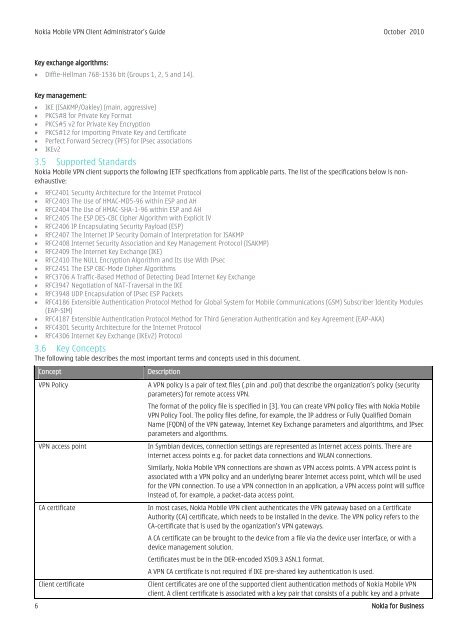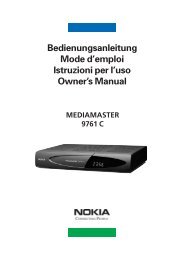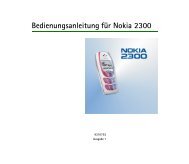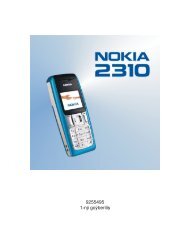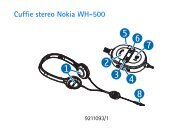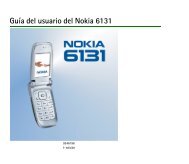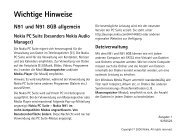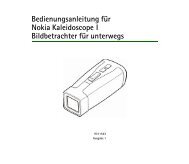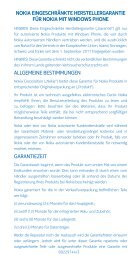Nokia mobile vpn client for symbian devices
Nokia mobile vpn client for symbian devices
Nokia mobile vpn client for symbian devices
Create successful ePaper yourself
Turn your PDF publications into a flip-book with our unique Google optimized e-Paper software.
<strong>Nokia</strong> Mobile VPN Client Administrator’s Guide October 2010<br />
Key exchange algorithms:<br />
Diffie-Hellman 768-1536 bit (Groups 1, 2, 5 and 14).<br />
Key management:<br />
IKE (ISAKMP/Oakley) (main, aggressive)<br />
PKCS#8 <strong>for</strong> Private Key Format<br />
PKCS#5 v2 <strong>for</strong> Private Key Encryption<br />
PKCS#12 <strong>for</strong> importing Private Key and Certificate<br />
Perfect Forward Secrecy (PFS) <strong>for</strong> IPsec associations<br />
IKEv2<br />
3.5 Supported Standards<br />
<strong>Nokia</strong> Mobile VPN <strong>client</strong> supports the following IETF specifications from applicable parts. The list of the specifications below is nonexhaustive:<br />
RFC2401 Security Architecture <strong>for</strong> the Internet Protocol<br />
RFC2403 The Use of HMAC-MD5-96 within ESP and AH<br />
RFC2404 The Use of HMAC-SHA-1-96 within ESP and AH<br />
RFC2405 The ESP DES-CBC Cipher Algorithm with Explicit IV<br />
RFC2406 IP Encapsulating Security Payload (ESP)<br />
RFC2407 The Internet IP Security Domain of Interpretation <strong>for</strong> ISAKMP<br />
RFC2408 Internet Security Association and Key Management Protocol (ISAKMP)<br />
RFC2409 The Internet Key Exchange (IKE)<br />
RFC2410 The NULL Encryption Algorithm and Its Use With IPsec<br />
RFC2451 The ESP CBC-Mode Cipher Algorithms<br />
RFC3706 A Traffic-Based Method of Detecting Dead Internet Key Exchange<br />
RFC3947 Negotiation of NAT-Traversal in the IKE<br />
RFC3948 UDP Encapsulation of IPsec ESP Packets<br />
RFC4186 Extensible Authentication Protocol Method <strong>for</strong> Global System <strong>for</strong> Mobile Communications (GSM) Subscriber Identity Modules<br />
(EAP-SIM)<br />
RFC4187 Extensible Authentication Protocol Method <strong>for</strong> Third Generation Authentication and Key Agreement (EAP-AKA)<br />
RFC4301 Security Architecture <strong>for</strong> the Internet Protocol<br />
RFC4306 Internet Key Exchange (IKEv2) Protocol<br />
3.6 Key Concepts<br />
The following table describes the most important terms and concepts used in this document.<br />
Concept Description<br />
VPN Policy A VPN policy is a pair of text files (.pin and .pol) that describe the organization’s policy (security<br />
parameters) <strong>for</strong> remote access VPN.<br />
The <strong>for</strong>mat of the policy file is specified in [3]. You can create VPN policy files with <strong>Nokia</strong> Mobile<br />
VPN Policy Tool. The policy files define, <strong>for</strong> example, the IP address or Fully Qualified Domain<br />
Name (FQDN) of the VPN gateway, Internet Key Exchange parameters and algorithtms, and IPsec<br />
parameters and algorithms.<br />
VPN access point In Symbian <strong>devices</strong>, connection settings are represented as Internet access points. There are<br />
internet access points e.g. <strong>for</strong> packet data connections and WLAN connections.<br />
Similarly, <strong>Nokia</strong> Mobile VPN connections are shown as VPN access points. A VPN access point is<br />
associated with a VPN policy and an underlying bearer Internet access point, which will be used<br />
<strong>for</strong> the VPN connection. To use a VPN connection in an application, a VPN access point will suffice<br />
instead of, <strong>for</strong> example, a packet-data access point.<br />
CA certificate In most cases, <strong>Nokia</strong> Mobile VPN <strong>client</strong> authenticates the VPN gateway based on a Certificate<br />
Authority (CA) certificate, which needs to be installed in the device. The VPN policy refers to the<br />
CA-certificate that is used by the oganization’s VPN gateways.<br />
A CA certificate can be brought to the device from a file via the device user interface, or with a<br />
device management solution.<br />
Certificates must be in the DER-encoded X509.3 ASN.1 <strong>for</strong>mat.<br />
A VPN CA certificate is not required if IKE pre-shared key authentication is used.<br />
Client certificate Client certificates are one of the supported <strong>client</strong> authentication methods of <strong>Nokia</strong> Mobile VPN<br />
<strong>client</strong>. A <strong>client</strong> certificate is associated with a key pair that consists of a public key and a private<br />
6 <strong>Nokia</strong> <strong>for</strong> Business


